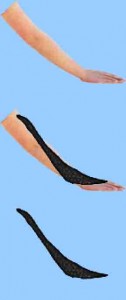The third of the 6 primary strokes is a stroke that slants downward toward the right, called 捺 (nà) in Chinese.
To form this stroke, 2 joints of the arm must shift position. From the previous position of the arm extending horizontally from the body, rotate the shoulder joint downward and inward 45o toward the right, such that the arm is between horizontal and vertical. The upper arm, the lower arm, and the hand extend along a single straight line. The wrist now shifts its position from before, lifting the hand upward, such that the hand extends horizontally toward the right. The fingers also make a change; once again the fingers of the hand are open and flat, parallel with the ground.
In the drawing of this stroke, Rule 1 and Rule 2 both apply, since this stroke is drawn both horizontally and vertically. In this case, both Rule 1 and Rule 2 are honored: This stroke is primarily drawn from top to bottom, but it is also drawn from left to right. Since both rules are honored, the stroke is represented by the right arm.
Notice that the emphasis is on the bottom of the stroke. In other words, there is greater pressure on the brush at the bottom of the stroke.
There is a shortened variation of this stroke. The elbow can be bent, rotating the forearm forward, upward, inward, and leftward, such that it is no longer visible.
The long form has an optional variation where the wrist does not bend upward to make the hand horizontal, but the wrist remains in line with the arm.
The character that means eternal (yǒng) contains the nà stroke; it is the bottom stroke on the right side.




